Demonstrations Page 3- Dipoles
and Solutions
Scroll down to view photographs and short descriptions of
some of the demonstrations in the list below.
WARNING – Use at your own risk! We cannot guarantee the accuracy or the safety of these activities. Some of these activities are far more dangerous than others. The contributors and Bradley University do not assume any responsibility for these activities or their results. If you have questions, corrections, or comments please do not hesitate to contact Dean Campbell (campbell@bumail.bradley.edu) at Bradley University.
- Ferrofluid
Demonstrations
- Refrigerator
Magnet Demonstrations
- Polydimethysiloxane
Demonstrations
- LEGO® Brick Chemistry and Nanotechnology Demonstrations
- Solvent Swelling Demonstrations
- When a solid is typically dissolved into a liquid, the solid
breaks up into individual molecules or ions which disperse throughout
the liquid as much as possible, forming a solution. But what
if the molecules in the solid are large enough to be all tangled
up with each other? The liquid disperses into the solid as much
as it can, but the solid still remains largely intact. The solid
does swell, however, as it absorbs liquid. This process is called
solvent swelling. Perhaps the most common example of this phenomenon
is pasta swelling in hot water as the water molecules slip in
between the starch molecules of the pasta. Here are some other
examples of solvent swelling:
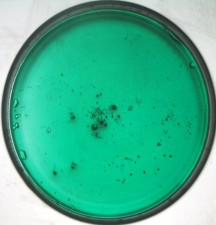
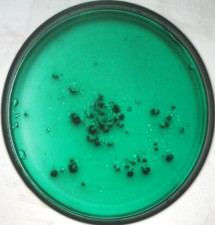
- ABOVE LEFT: The superabsorbent polymer powder from a disposable
diaper is placed in a Petri dish that contains a shallow pool
of water (with green food coloring added). ABOVE RIGHT: The powder
solvent-swells as it absorbs water (elapsed time: 10 min). These
photographs were taken of the image on an overhead projector
screen.
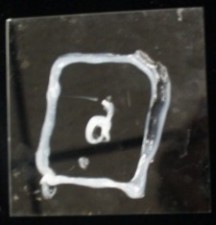
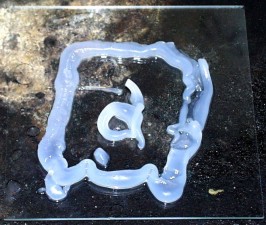
- ABOVE LEFT: Silicone caulk that has cured overnight on a
glass plate. ABOVE RIGHT: The cured caulk solvent swells in contact
with toluene (elapsed time: 1 hour).

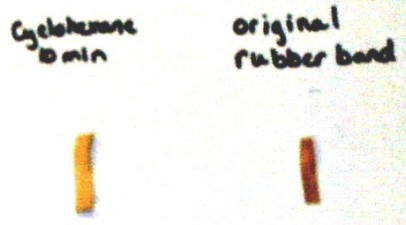
- ABOVE LEFT: Segments of rubber bands. The one on the left
has been solvent swelled by soaking in toluene for 10 min. ABOVE
RIGHT: Segments of rubber bands. The one on the left has been
solvent swelled by soaking in cyclohexane for 10 min.
-
- More information:
- Campbell, Dean J.; Rupe, Sarah B. Solvent Swelling and Optical
Rotation Demonstrated on the Overhead Projector J. Chem Educ.
2000 77 876.
-
- Ross, Joseph H. Demonstration of solvent differences by visible
polymer swelling J. Chem Educ. 1983 60 169.
-
- "Like Dissolves Like" - A
Children's Toy
- A simple demonstration polar and nonpoloar solutes and solvents
may be made using a clear plastic bottle, yellow cooking oil,
water, and food coloring. The dye components in many food colorings
are polar and would rather stay dissolved in water rather than
in nonpolar cooking oil. Therefore one can make a bottle half-filled
with oil and half-filled with water and food coloring. When the
bottle is shaken the two layers temporarily mix, yielding a different
color (ie. yellow and blue combine to make green - a good illustration
of color mixing). The bottle cap can be superglued or epoxied
to the bottle to keep the contents in the bottle. Bottles of
this sort have been used at day care centers for years (special
thanks to Karen Campbell for introducing this demonstration to
me).


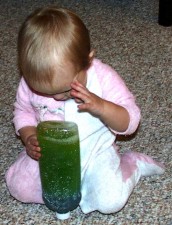
- ABOVE LEFT: Bottle with separated layers: oil on top (ferrocene
added to enhance the yellow color) and water and blue food coloring
on the bottom.
- ABOVE MIDDLE: The shaken bottle (note the mixed green color).
The separation will return in a few minutes.
- ABOVE RIGHT: My daughter playing with the sealed bottle.
-
- Electrorheological (ER) Fluid
(application of a high voltage across a slurry of cornstarch
and corn oil reversibly increases the viscosity of the slurry)
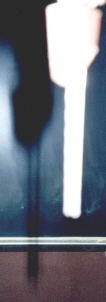

- ABOVE: OK, so the pictures of the electrodes did not turn
out that well. But, the shadows of the electrodes on the
blackboard are visible. At left are a pair of bare electrodes
with no voltage applied; at right are the electrodes with the
ER fluid suspended between them due to 2500 applied volts.
-
- Flash Rocks
- Certain quartz-containing rocks will emit a yellow flash
when struck together. Generally speaking the best rocks to use
are rounded white quartzite pebbles. When the rocks are struck
together with a glancing blow, the tiny quartz crystals within
the quartzite are compressed. These crystals apparently build
up charges due to the piezoelectric effect. The charges recombine
within the rock (sort of an internal sparking) producing yellowish
flashes and sometimes a burnt sulfur smell.


- ABOVE LEFT: Striking (in this case vigorously rubbing) two
quartz-laden rocks together.
- ABOVE RIGHT: A faint flash from these rocks. Photographing
the flashes is extremely difficult; the flashes are best seen
in person.
Return to Dr. Campbell's Favorite
Demonstrations
Last updated 1/17/12
Site created at the laboratory of Dean Campbell





















